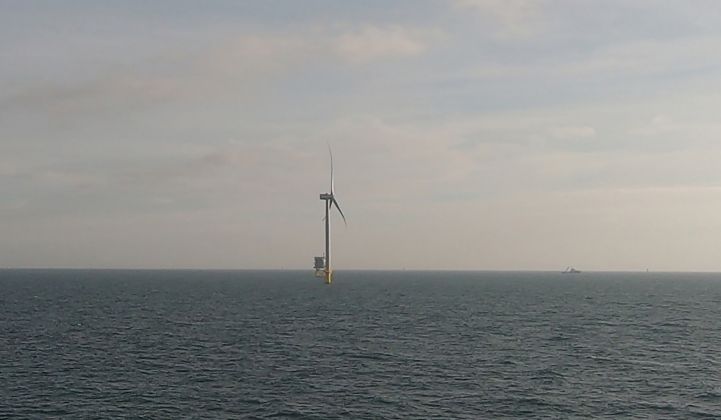A giant offshore wind project has reignited debate over whether the intermittent renewable energy technology could one day replace nuclear power.
Danish developer Ørsted said its Hornsea One plant, which started delivering power to the grid this month, could help make up for a lack of planned nuclear generation in the U.K., as plans for new reactors have fallen by the wayside.
When complete, Hornsea One will cover more than 157 square miles, making it bigger than the city of Denver, and have a peak capacity of 1.2 gigawatts, thanks to 174 turbines of at least 7 megawatts each.
It will be the biggest offshore wind plant on the planet, dwarfing the current leader, Walney Extension, which Ørsted opened last September with a capacity of 659 megawatts. Ørsted has plans for an even bigger project, the 1.8-gigawatt Hornsea Two plant, in U.K. waters.
In an interview with The Guardian after two Japanese firms pulled out of building new British reactors, Henrik Poulsen, Ørsted’s chief executive, said that in the future, “if nuclear should play less of a role than expected, I believe offshore wind can step up.”
A battle of capacity factors
Can it, though? Depending on conditions, the U.K. already gets more than a third of its energy from variable wind generation.
This month the country smashed a new record, with 15.32 gigawatts of power delivering 36 percent of the nation’s electricity, said RenewableUK, an industry body.
It may seem risky to further increase the country’s reliance on a generation source that depends on meteorological conditions. However, advocates point out that offshore wind is a more reliable energy source than the onshore variety, particularly as turbine sizes grow.
According to one analysis in 2017, the capacity factors of U.K. offshore wind farms have risen from roughly 30 percent to 40 percent from early to later projects, mainly as a result of installing larger turbines.
The analysis concluded Hornsea Two, if built, could potentially have a capacity factor in excess of 60 percent. That’s still below the capacity factors nuclear typically achieves, but perhaps not as much as you might think.
While U.S. reactors have average capacity factors of around 90 percent, in the U.K. the level is significantly lower. World Nuclear Association figures show an average U.K. nuclear plant load factor of less than 82 percent in 2017.
This was quite a high level for the U.K. fleet, according to a review of capacity factors by British anti-nuclear campaigner Peter Lux.
He claims the U.K. fleet’s “consistently awful” capacity factors are a result of the country installing reactor designs not widely used elsewhere, which limits the potential to acquire expertise in operating the technology.
Other data supports the idea that new nuclear technologies face a learning curve before achieving high capacity factors.
U.S. Energy Information Administration records, for example, show America’s nuclear fleet was still struggling to achieve capacity factors above 60 percent a decade after it began contributing double-digit percentage shares of generation to the grid.
Not just a U.K. debate
Given that the U.K. is relying on a largely untested reactor design for upcoming nuclear capacity, it is perhaps legitimate to ask if the reliability of new reactors will be significantly greater than those of gigawatt-scale offshore wind farms built at the same time.
Tim Dixon, wholesale team leader at U.K. consultancy Cornwall Insight, said: "New offshore wind farms being developed are now much more reliable than older offshore sites or their onshore counterparts.”
As a result, he said, "it is credible to say that the shortfall in new nuclear could be made up by offshore wind, with improving operational performance and relatively low costs for the technology, but additional flexibility would be required at times when output is low."
It is not just the U.K. where offshore wind could potentially take over new nuclear’s mantle.
This month, in the wake of a partnership between Ørsted and Tokyo Electric Power Company, the analyst firm Wood Mackenzie Power & Renewables questioned whether offshore wind could also be a cure for rising energy demand as new nuclear languishes in Japan.
"Rising costs and a lack of public confidence in Tepco's ability as a nuclear operator have led the company to reconsider its future strategy," said WoodMac senior analyst Robert Liew. "Tepco's involvement in offshore wind is a crucial development."




